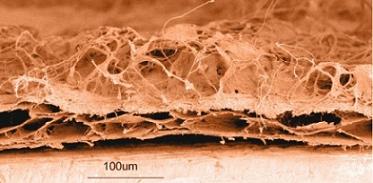美国石溪大学(Stony Brook University)的研究人员开发出一种电子鼻(electronic nose)传感器,不只能用来侦测疾病,还能诊断出其发展状况;这种以纳米线阵列(nanowire-arrays)组成的超灵敏传感器,与传统方案相较,能提供更高的气体敏感度、更快的反应速度,以及较低的检测阶层,也就是可能不需要抽血、只要用呼吸就可进行疾病诊断。
该款由石溪大学纳米材料与传感器开发中心教授Perena Gouma率领的研究团队所开发之超灵敏传感器,目前正进入临床试验阶段。在测试中,糖尿病患者将使用该电子鼻来侦测呼吸中的丙酮(acetone)浓度;研究人员表示,该浓度数据会与该疾病所压抑的血糖浓度成正比,并因此不需要再采取血液样本。
根据Gouma的说法,让电子鼻能辨别特定病患的呼吸中所含有的化学标记,就能以更简单的方法来侦测或是控制疾病。举例来说,针对气喘病患者,能用内含一氧化碳传感器的电子鼻来追踪其病况;甚至是肺癌等更严重的、在早期阶段难以侦测到的疾病,电子鼻也能辨别得出来。

电子鼻是利用电纺纳米纤维(electrospinning nanofiber)以及纳米线所打造的传感器,嗅出疾病的化学标记
点击进入参考原文:Electronic nose sniffs out medical conditions, by R. Colin Johnson
《电子工程专辑》网站版权所有,谢绝转载
{pagination}
Electronic nose sniffs out medical conditions
by R. Colin Johnson
Electronic nose sensors can not only detect disease but can also diagnose its progress, according to Stony Brook University researchers. Nanowire-arrays of ultrasensitive sensors offer improved gas sensitivity, faster response and lower level detection than conventional approaches, promising to eliminate the need for blood tests in favor of breath-based diagnoses, the researchers say.
Led by Professor Perena Gouma, director of the Center for Nanomaterials and Sensor Development at Stony Brook, the super-sensitive sensors are currently entering the clinical trial stage. In the trials, diabetes patients will use the electronic nose to detect the levels of acetone in their breath, which the researchers say are elevated in direct proportion to how much the disease has depressed blood sugar levels, thus eliminating the need for taking a blood sample.
According to Gouma, many diseases could be more easily detected and controlled by using an electronic nose tuned to the specific chemical markers found only in the breath of patients suffering from that malady. For instance, for asthma, a nitric oxide sensor would allow an electronic nose to track that condition. Even serious diseases like lung cancer, which is hard to detect in early stages, can be sensed by an electronic nose, according to Gouma.
Funding for the Stony Brook project was provided by the National Science Foundation for pre-clinical trials of the diabetes sensor.